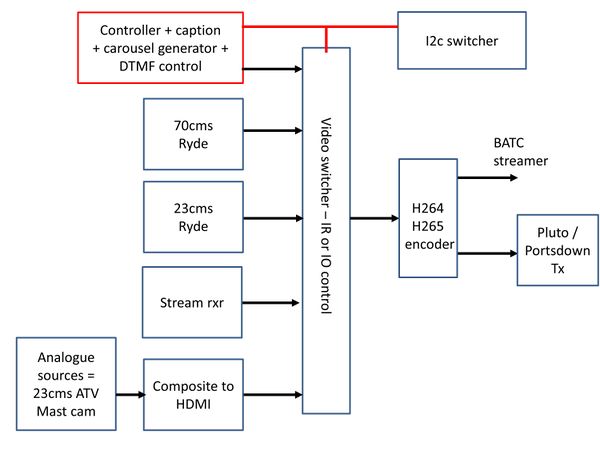Difference between revisions of "Repeater Controller"
| Line 1: | Line 1: | ||
The BATC ATV Repeater Controller uses a Raspberry Pi 4 as a fully-featured, but simple-to-construct, ATV repeater controller. The design is intended to be used with an HDMI Video switch, but can also be used with older composite video designs. | The BATC ATV Repeater Controller uses a Raspberry Pi 4 as a fully-featured, but simple-to-construct, ATV repeater controller. The design is intended to be used with an HDMI Video switch, but can also be used with older composite video designs. | ||
| − | [[File:HDMI repeater.jpg| | + | [[File:HDMI repeater.jpg|600px|center]] |
The RPi will control a video switcher either by Infra Red or GPIO pins and will generate a carousel of images. On receipt of a valid signal from, for example, a Ryde receiver, it will switch to that input - when the receiver closes, the logic will play a key sequence, dekey the tx and go back to the carousel. | The RPi will control a video switcher either by Infra Red or GPIO pins and will generate a carousel of images. On receipt of a valid signal from, for example, a Ryde receiver, it will switch to that input - when the receiver closes, the logic will play a key sequence, dekey the tx and go back to the carousel. | ||
Revision as of 13:03, 12 January 2022
The BATC ATV Repeater Controller uses a Raspberry Pi 4 as a fully-featured, but simple-to-construct, ATV repeater controller. The design is intended to be used with an HDMI Video switch, but can also be used with older composite video designs.
The RPi will control a video switcher either by Infra Red or GPIO pins and will generate a carousel of images. On receipt of a valid signal from, for example, a Ryde receiver, it will switch to that input - when the receiver closes, the logic will play a key sequence, dekey the tx and go back to the carousel.
Every repeater is different and this is designed as a core logic that can be used as the basis for an ATV repeater. The design is flexible with a large number of parameters in an SSH config file so that users can configure it to meet their own needs.
Initial design and construction information will be published here to enable collaborative development, but will be subject to change as the project develops.
GPIO Connections
An initial list of GPIO connections is here: Repeater GPIO Connections.
